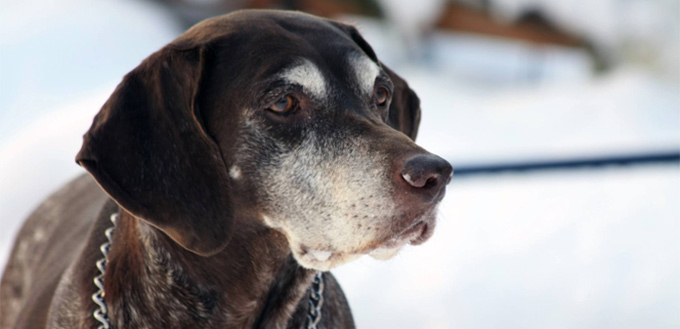Just like humans, as a dog gets older, their skin starts to show the ravages of time, which can result in growths, including skin tags. A skin tag is a type of growth that consists of fibrous tissue. It can appear as a multiple or single bump or lump. In most cases, these growths will be harmless. However, this does not mean they should simply be ignored, especially if your dog is scratching, seems to be in pain, or is bothered by the growth. Skin tags can appear anywhere on a dog’s body, and they are also referred to as a range of other names, including achrochordons, skin poly, dog warts, fibrin tags, and fibropapillomas. These growths are fleshy; some are stalk-like and flat whereas others are round. You can also get those that are small and appear like a grain of rice, whereas others a big and can grow to the size of a grape.

The Two Types of Skin Tags in Dogs
There are two main categories of skin tags in dogs: follicular hamartomas and fibroadnexal hamartomas. The former is the rarer of the two. These are multiple growths, which have thick hairs and a flattened mass. Fibroadnexal hamartomas, also known as collagenous hamartomas, are the more common form of skin tags in dogs. These form near pressure points and lower limb regions, and they tend to be hairless.
What Causes Skin Tags?
While there have been a number of theories developed by experts regarding skin tag development, veterinarians do not know precisely what causes these wart-like bumps. Nevertheless, here are some of the factors that have been attributed to their presence:
- A bad fitting collar
- Poor nutrition
- Genetic makeup
- Too little or too much bathing
- Skin care products
- Parasites
- Environmental factors
Take a look at our articles on the Best Dog Shampoo, Best Dog Shampoo for Puppies and Best Medicated Dog Shampoos.
How to Prevent Skin Tags in Dogs
When you take a look at the various causes for skin tags, it highlights a number of steps you can take to ensure that your dog does not suffer from these growths. This includes the following:
- Improve your dog’s diet – Skin malformations can develop if a dog is not properly fed. If he is eating something that he should not be, or he is not getting the correct nutrition, it can weaken your pet’s immune system, which can lead to cracks and rashes in the skin, and of course, skin tags.
- Improving your dog’s skin care regime: Dogs need to be bathed on a frequent basis, depending on their breed, of course. However, if you are an owner that bathes your dog the moment you notice a slight smell, it could be that you are washing your dog too much. This stops the skin from creating the natural oils that are required for a healthy coat. Not only this, but harsh shampoos and soaps can cause tags to develop because they also dry out the skin by stripping away oils. Switch to an organic shampoo that has been specially developed for dogs.
- Buy a new collar for your dog – Make sure your dog’s collar fits properly. To make certain that your dog’s collar fits properly, measure around your pet’s neck using a soft measuring tape, and then add an inch on top of this. Make sure you measure around the upper part of your pet’s neck so that the collar will not be too loose and slip off over the ears.
Related Post: Best Dog Collars
Skin Tag Symptoms to Look Out For
It can take some time to notice skin tags, as they tend to grow slowly. However, there are a few signs you can look out for, including:
- Secondary infections of growth
- Growths that bleed if they are damaged
- Flattened plaque-like growths
- Growths that have hair follicles
- Multiple or single growths
- Growths with a wart-like surface
- Stalk-like growths
How to Remove Dog Skin Tags
You may be tempted to remove the skin tag yourself, but this is not recommended. A lot of people ponder whether it is simple as simply snipping the growth right off. But it is important to remember that this is still part of your dog’s skin, and so any form of cutting can result in an open wound and bleeding. This can then result in infection and bacteria, which is why you need to have the right medication and sterile equipment. The matter only becomes even more complicated if the skin tag is situated in a sensitive or unusual area, such as the mouth or eyelids. This is why it is better to take a trip to see your vet. You may even find that your vet tells you the growth doesn’t need to be removed.

So, how will the veterinarian remove the growth? In most cases, this will be an outpatient affair. Your dog will receive local anaesthetic so that the area around the skin tag is numbed. If your dog is overly skittish or aggressive, you may be required to hold him down so that the vet can get on with the procedure. The tag will then be sliced away once the anaesthetic sets in. Your dog will not be in any pain. There will not typically be any sewing required, as there is only a small amount of cutting involved. Over the next week or so, you need to monitor the wound and make sure your dog does not scratch the area.
If you have noticed that your dog has a skin tag, there is no need to panic. In most cases, skin tags are completely harmless. However, this does not mean that they should be ignored. This is especially the case if your dog is notably bothered by the growth and seems to be scratching it. The best thing to do is see your vet. They may tell you that the skin tag doesn’t need to be removed, but at least your mind will be put at ease.
Sources:
- Debbie Stoewen DVM, Benign Fibrous Skin Tumors, VCA
- Jennifer Coates, DVM, All About Dog Warts: Types, Causes, and Treatments, PetMD







